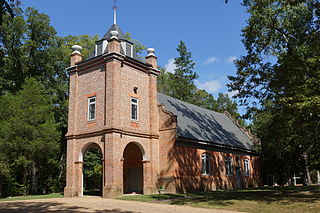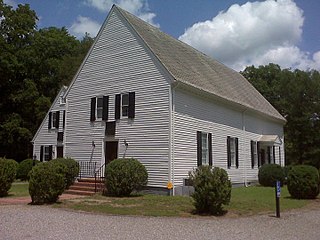
Rosewell Plantation in Gloucester County, Virginia, was for more than 100 years the home of a branch of the Page family, one of the First Families of Virginia. Begun in 1725, the Flemish bond brick Rosewell mansion overlooking the York River was one of the most elaborate homes in the American colonies.

Christ Episcopal Church is a historic Episcopal church located at 43 South Broadway in Tarrytown, New York. Topped by a modest tower, the ivy-covered red brick church was built in 1837 and maintains an active congregation to the present day. The church also includes the San Marcos Mission, a Spanish-language ministry.

Christ Church is an Episcopal church located at 118 North Washington Street, with an entrance at 141 North Columbus Street, in Alexandria, Virginia. Constructed as the main church in the Church of England's Fairfax Parish, the building was designed by Col. James Wren, a descendant of Sir Christopher Wren.

Pohick Church, previously known as Pohick Episcopal Church, is an Episcopal church in the community of Lorton in Fairfax County, Virginia, United States. Often called the "Mother Church of Northern Virginia," the church is notable for its association with important figures in early Virginian history such as George Washington and George Mason, both of whom served on its vestry.

St. Luke's Church, also known as Old Brick Church, or Newport Parish Church, is a historic church building, located in the unincorporated community of Benns Church, near Smithfield in Isle of Wight County, Virginia, United States. It is the oldest church in Virginia and oldest church in British North America of brick construction. According to local tradition the structure was built in 1632, but other evidence points to a date of 1682; see Dating controversy.
Merchant's Hope was the name of a plantation and church established in the Virginia Colony in the 17th century. It was also the name of an English sailing ship, Merchant's Hope, which plied the Atlantic bringing emigrants to Virginia in the early 17th-century. The Merchant's Hope was owned by a man named William Barker who was a wealthy English merchant and mariner who patented land in Virginia.

Christ Church — known also as Christ Church, Washington Parish or Christ Church on Capitol Hill — is a historic Episcopal church located at 620 G Street SE in Washington, D.C., USA. The church is also called Christ Church, Navy Yard, because of its proximity to the Washington Navy Yard and the nearby U.S. Marine Barracks.

St. James Church, Santee, also known as St. James Episcopal Church, Santee, is a historic church located in a remote portion of Francis Marion National Forest in Charleston County, South Carolina. Built in 1768, it is a remarkably sophisticated expression of fashionable Georgian architecture in a remote area, and was designated a National Historic Landmark in 1970 for its architectural significance. It is located on the west side of the Old Georgetown Road, several miles north of South Carolina Highway 46 and McClellanville.
St. Michael's AnglicanChurch is a historic church and the oldest surviving religious structure in Charleston, South Carolina. It is located at Broad and Meeting streets on one of the Four Corners of Law, and represents ecclesiastical law. It was built in the 1750s by order of the South Carolina Assembly. It is listed on the National Register of Historic Places and is a National Historic Landmark.

Yeocomico Church is a historic Episcopal church in Westmoreland County in the U.S. state of Virginia. The original wooden structure was built in 1655, but replaced in 1706 by a structure built of locally fired bricks. It is now the main church of historic Cople parish, which also includes the older Nomini Church, and St. James Church in Tidwells, Virginia The parish hall is in Hague, Virginia. Yeocomico Church, the fourth oldest in the state, was designated as a National Historic Landmark in 1970.

Little Fork Church stands on a low knoll to the east of State Route 229 nine miles north of Culpeper, Virginia in a small grove of trees that enhances its naturally pastoral setting. The name Little Fork is taken from the junction of the Hazel and Rappahannock Rivers relatively close to the edifice. It is a large room church being 83 1⁄2 feet east–west and 33 1⁄2 feet north–south. Unlike most rectangular churches in Virginia, the pulpit stands directly north of the southern entrance door that is placed in the middle of the southern wall rather than in the far southeast of the building. Thus it shows some of the architectural characteristics of middle colony meeting houses such as those in Delaware as well as the Virginia Vernacular Church and the deep church.

St. Peter's Church is a historic Episcopal church near Talleysville, Virginia, United States. Built in 1703, the church was designated as "The First Church of the First First-Lady" by the Virginia General Assembly in 1960 and added to the National Register of Historic Places in 1969. It was designated a National Historic Landmark on March 2, 2012, as an exceptionally well-preserved colonial-era church.
Founded in 1886, Weems is an unincorporated community and census-designated place (CDP) in Lancaster County in the U. S. state of Virginia. It was first drawn as a CDP prior to the 2020 census.

St Mary's Whitechapel is an Episcopal church in Lancaster, Virginia, founded in 1669, and located three miles south of Lively, in Lancaster County, in the Northern Neck. The parish of St Mary's Whitechapel is notable for being the church of Mary Ball Washington, mother of George Washington, during her youth.

Corotoman was a 17th and 18th century plantation on the Rappahannock River in Lancaster County, Virginia, United States. Corotoman was the residence of Robert Carter I, a colonial Governor of Virginia and one of the wealthiest men in the British colonies in North America. Corotoman was located on a point overlooking the Rappahannock River, and flanked by Carter's Creek and Corrotoman River to its east and west respectively.

St. Stephen's Church, also known as St. Stephen's Episcopal Church, is an historic church located at 6807 Northumberland Highway, Heathsville, Northumberland County, in the Northern Neck of Virginia. Built in 1881, it was designed in the Carpenter Gothic style by T. Buckler Ghequiere. On December 28, 1979, it was added to the National Register of Historic Places. It remains in use by an active parish in the Episcopal Diocese of Virginia. It is located in the Heathsville Historic District.

Old Chapel is a historic Episcopal church building located near Millwood, Clarke County, Virginia. Old Chapel is now the oldest Episcopal church building still in use west of the Blue Ridge Mountains. It was listed on the National Register of Historic Places in 1973. In 2014, the Chapel Rural Historic District was recognized, and which encompasses both Cunningham parish churches, discussed below, as well as approximately 700 other structures and an area of nearly 10,500 acres.

St. Thomas Chapel, also known as St. Thomas Episcopal Church or St. Thomas Protestant Episcopal Chapel, is a historic building located at 7854 Church Street in Middletown, Frederick County, Virginia, United States. Built in the 1830s, regular services were held at the Episcopal church for almost 100 years. The building has been restored twice, once after being heavily damaged during the Civil War, and again in the 1960s. The church was added to the Virginia Landmarks Register (VLR) and the National Register of Historic Places (NRHP) in 1973.

Slash Church, also known as the Upper Church-St. Paul's Parish is a historic Disciples of Christ Church, formerly an Anglican/Episcopal church located at 11353 Mt. Hermon Road, Ashland, Hanover County, Virginia. Built of southern yellow pine cut from the property in 1729–30, it is the oldest frame house of worship still in use in Virginia.

Hungars Church, also known as Hungars Parish Church, is a historic Episcopal church located at Bridgetown, Northampton County, Virginia. Since 1828, when an additional church was constructed about nine miles away in Eastville, the parish has had two churches.


























